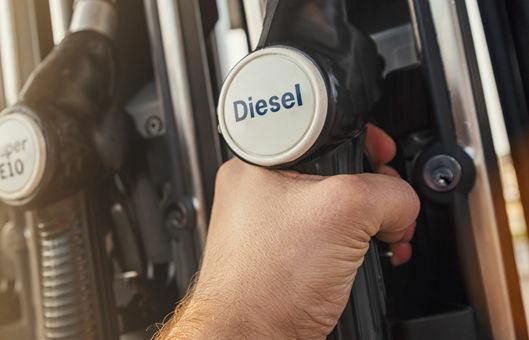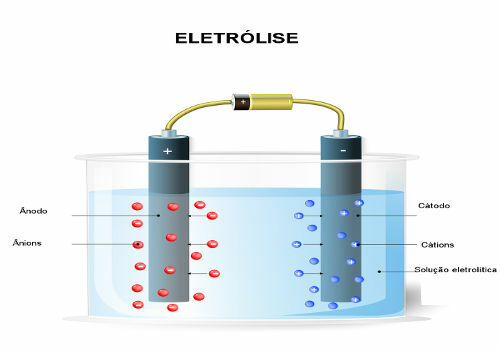Petroleum it is a fossil fuel which corresponds to a an oily substance whose density is less than that of water and is flammable. It is considered one of the main natural resources used as power supply of today.
Oil, despite having been known before, started to be explored in the mid-nineteenth century and used on a large scale with the creation of engines powered by gasoline or diesel oil. In the 70s, oil was the mainstay of the economy, accounting for almost 50% of the world's energy consumption and even though its use is currently giving way to alternative energy sources, is still one of the most used energy sources in the world.
Origin
The oil originates from the organic matter decomposition, especially plankton. Bacteria in low oxygen environments carry out the decomposition activity that ends up accumulating in subsoil layers found in sedimentary basins, on the ocean floor, on the bottom of seas or lakes and under specific pressure conditions. Over the years, these deposits undergo several modifications until they are transformed into what corresponds to the oily substance, petroleum.
Do not stop now... There's more after the advertising ;)
Composition
According to the National Department of Mineral Production (DNPM), oil is a mixture of hydrocarbons (carbon and hydrogen molecules) that are in a liquid state (at ambient temperature and pressure). It is also made up of sulfur compounds, nitrogen compounds, oxygen compounds, resins, asphaltenes and metals such as iron, copper and zinc.
The DNPM classifies oil according to the by-products generated after refining:
paraffin class |
Corresponds to light and low viscosity oils. The resin and asphaltene content is less than 10%. |
Naphthenic paraffin class |
Corresponds to oils with moderate viscosity and density. The resin and asphaltene content is 5 to 15%. |
naphthenic class |
Corresponds to the least representative oils in relation to the total volume of oil. Its origin is related to the biochemical alteration of paraffinic and paraffin-naphthenic oils. |
Intermediate aromatic class |
Corresponds to heavy oils. The resin and asphaltene content is 10 to 30%. This is usually found in the Middle East and on Venezuela. |
Aromatic-naphthenic class |
Corresponds to oils originated from the degradation processes of paraffinic oils. The resin and asphaltene content is over 35%. Generally found in West Africa. |
Aromatic-asphalt class |
Corresponds to oils originated from biodegradation processes. The resin and asphaltene content is over 35%. It can be found in Canada, Venezuela and France. |
According to the National Agency for Petroleum, Natural Gas and Biofuels (ANP), the chemical composition of oil, with regard to the proportion of its components, would be, in general (which may vary depending on the sample):
Carbon: 82%
Hydrogen: 12%
Nitrogen: 4%
Oxygen: 1%
Salts: 0.5%
Metals: 0.5%
readalso:Organic composition of oil
Mind Map: Oil

*To download the mind map in PDF, Click here!
History
The use of oil is believed to date back to the beginnings of civilization. Peoples from the Middle East, Egypt, Mesopotamia, China had already had contact with fossil fuel and used in the forms of bitumen, asphalt for road paving, lighting, lubrication, purposes warlike.
The oil industry emerged in the mid-19th century, when the oil refining process was developed in Scotland. O Azerbaijan was, in that period, the biggest oil producer, its production corresponded to more than 50% of the world production. On the American continent, oil was first found in Canada. In 1859, production began in the United States through a well of approximately 21 meters drilled in Pennsylvania.
In 1960, theOrganization of Petroleum Exporting Countries (OPEC), made up of countries that represent about 25% of the world's oil reserves. The organization's aim is to strengthen oil-producing countries before the Marketplaceconsumer, restricting the supply of oil in the market, as well as boosting prices in the international market.
knowmore:Oil in Brazil

Petrobras is the state-owned company responsible for oil exploration and production in Brazil.*
In Brazilian territory, the oil was found in 1939, in the state of Bahia, and, after two years, a deposit that was economically viable for extraction was found in the same state. In the year 1954, the Petrobras institutes the state monopoly, starting to explore national oil.
In 2006, Petrobras announced the existence of Brazilian pre-salt, an oil field found beneath a thick layer of salt. The exploration of the reserve actually started in 2010. To learn more about the Brazilian pre-salt, Click here.
What is oil for?
Oil, an essential energy source for the maintenance of society, is also used as a raw material, according to DNPM, for the manufacture of plastics, synthetic rubbers, paints, solvents, cosmetic products, among others.
→ Petroleum Derivatives

Diesel oil used mainly in transport is one of the petroleum derivatives.
Petroleum derivatives are obtained from what they call refining. Oil does not come out of reservoirs ready to be sold, so it needs to go through an improvement process in order to meet market specifications. Refining is done through chemical processes, such as cracking, reforming, alkylation, hydrotreatment, among others.
According to the ANP, they can be obtained from oil:
Petroleum gas: used for heating and industry
Liquefied petroleum gas: used in the kitchen
Naphtha: raw material for the petrochemical industry and also transformed into gasoline
Gasoline: used as fuel
Kerosene: used as fuel for jet turbines
Diesel oil: used especially in road transport, waterway and also in thermoelectric plants
Fuel oil: used as a heat source in industry
Waste: are products used as material to manufacture other products (coke, asphalt, waxes)
Obtaining oil
Oil can be found in sedimentary basins, which are normally found in deposits far from the surface. Thus, the process of obtaining oil requires specific equipment and applied technologies.
These instruments make it possible to drill through the rock by exerting pressure on it causing the oil to rise to the surface. This extraction must be planned and studied, since the difficulty encountered in drilling often makes the process unfeasible and not at all economically advantageous.
knowalso: How is oil transported?
→ Extraction
The oil extraction process is carried out through three basic steps:
Prospection: represents the stage of locating deposits in sedimentary basins based on analyzes and observations of the subsoil in the region.
Drilling: The deposits, when found, are marked and subsequently drilled in order to analyze the economic feasibility of extraction.
Extraction: Using special equipment, extraction is carried out. Pumps are used on platforms and ships, when extraction is carried out on the ocean floor. On land, the necessary equipment is used to pump or squirt out the oil found.
To learn more about the oil extraction process, Click here.
Countries with the largest oil reserves
According to OPEC, in the year 2018, the world consumed oil like never before: around 98.82 million barrels per day. The countries with the largest reserves in the world are, according to data from the United States Intelligence Agency (CIA):
Venezuela: 300.9 billion barrels
Saudi Arabia: 266.5 billion barrels
Canada: 169.7 billion barrels
Will: 158.4 billion barrels
Iraq: 142.5 billion barrels
In the ranking, the United States is in 11th position, with 36.5 billion barrels, and Brazil in 15th position, with 12.7 billion.
*Image credits: David Herraez Calzada / Shutterstock
*Mental Map by Me. Diogo Lopes
by Rafaela Sousa
Graduated in Geography


